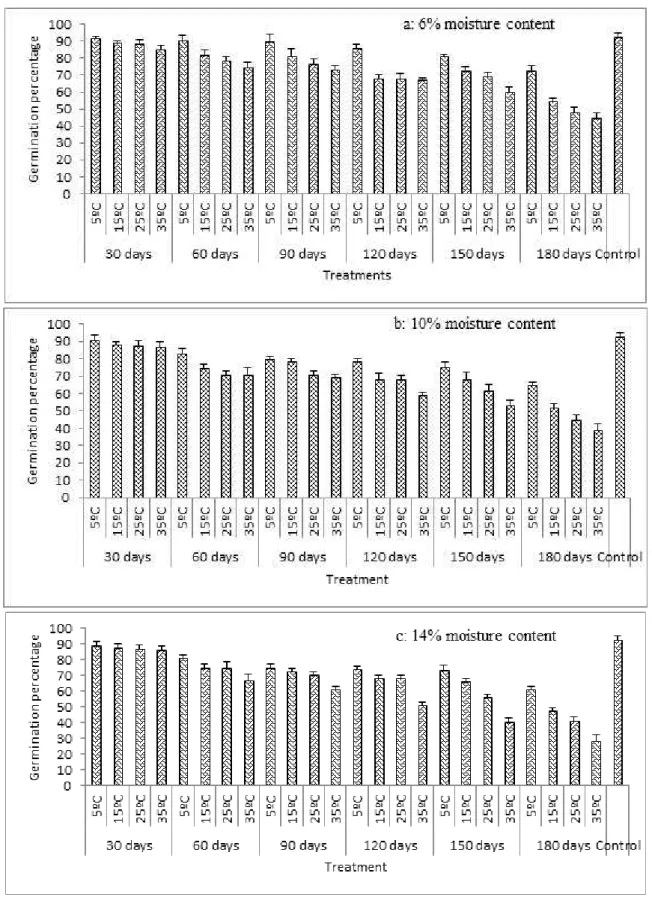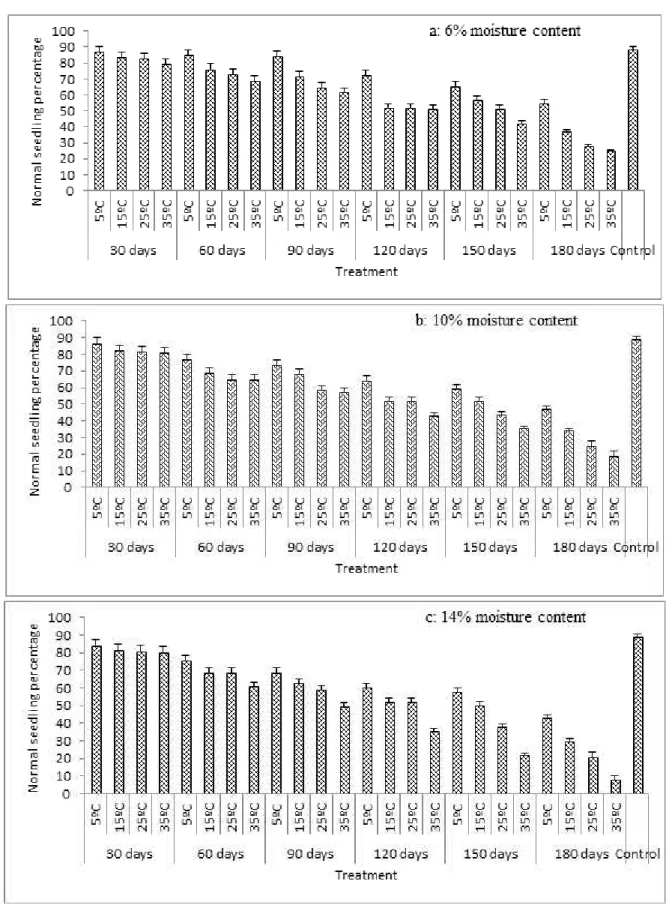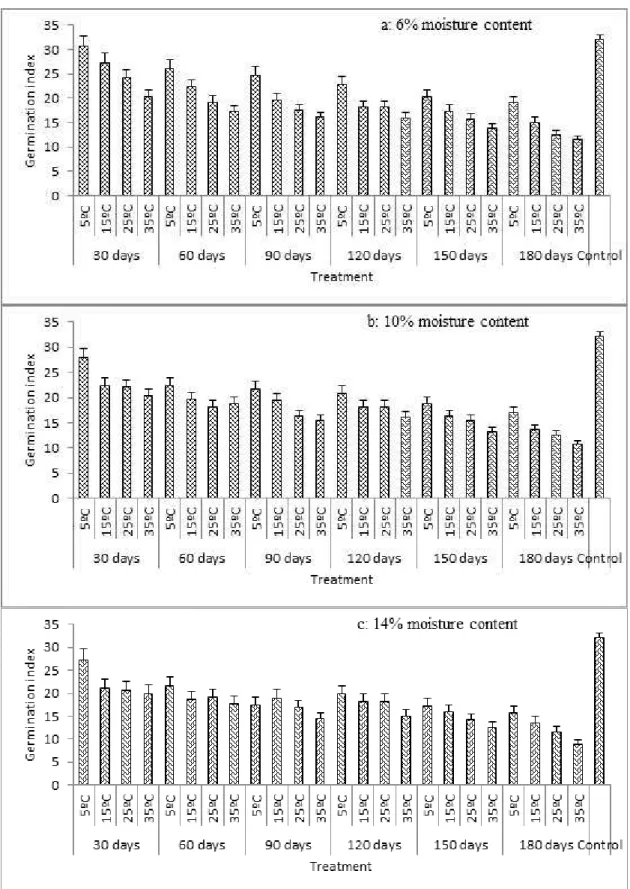Original Text Copyright © 2013 by Azadi, Younesi
ORIGINAL ARTICLE
The Effects of Storage on Germination Characteristics and Enzyme
Activity of Sorghum Seeds
Azadi M.S.
1, Younesi E.
2*
1 Department of Agronomy and Plant Breeding, Islamic Azad University, Dezfoul Branch, Iran.
2 Department of Agronomy and Plant Breeding, Faculty of Agriculture, University of Tehran, Karaj, Iran.
*E-Mail:
younesiehsan@ut.ac.ir
Received July 23, 2013
Seed moisture content (MC) and storage temperature are the most important factors affecting seed longevity and vigor. Exposure to warm, moist air is principally responsible for this. Proper storage and optimum seed moisture content can affect the grain quality significantly. The purpose of this study was to evaluate the different storage treatments on seed quality of sorghum. The seed materials were fresh without any storage period. For storage treatments, 3 seed moisture contents (6, 10, 14 %) were stored for 8 month in 0.5 L capacity sealed aluminum foil packet in 0.3 bar inside incubators set at 4 temperatures (5, 15, 25, 35°C). After storage time, the higher the storage temperature, the lower was the grain quality of sorghum. The highest germination percentage, germination index, normal seedling percentage were achieved in control conditions (0 day of storage). Our results showed that increasing storage duration resulted higher reduction in germination characteristics. Also our results showed that, germination percentage, means time to germination, germination index, normal seedling percentage decrease significantly by storage. Enzyme activity decrease significantly by increased in storage.
ORIGINAL ARTICLE
The Effects of Storage on Germination Characteristics and Enzyme
Activity of Sorghum Seeds
Azadi. M.S.
1, Younesi. E.
2*
1
Department of Agronomy and Plant Breeding, Islamic Azad University, Dezfoul Branch, Iran.
2 Department of Agronomy and Plant Breeding, Faculty of Agriculture, University of Tehran, Karaj, Iran.
*E-Mail:
younesiehsan@ut.ac.ir
Received July 23, 2013
Seed moisture content (MC) and storage temperature are the most important factors affecting seed longevity and vigor. Exposure to warm, moist air is principally responsible for this. Proper storage and optimum seed moisture content can affect the grain quality significantly. The purpose of this study was to evaluate the different storage treatments on seed quality of sorghum. The seed materials were fresh without any storage period. For storage treatments, 3 seed moisture contents (6, 10, 14 %) were stored for 8 month in 0.5 L capacity sealed aluminum foil packet in 0.3 bar inside incubators set at 4 temperatures (5, 15, 25, 35°C). After storage time, the higher the storage temperature, the lower was the grain quality of sorghum. The highest germination percentage, germination index, normal seedling percentage were achieved in control conditions (0 day of storage). Our results showed that increasing storage duration resulted higher reduction in germination characteristics. Also our results showed that, germination percentage, means time to germination, germination index, normal seedling percentage decrease significantly by storage. Enzyme activity decrease significantly by increased in storage.
Key words: Storage, Germination characteristics, Sorghum, enzyme activity.
Seed characteristics decrease under long storage
condition due to aging. Changes that occur in seed
during aging are significant in terms of seed quality,
the feature that, among other things, also implies
seed longevity (McDonald, 1999). Progress of the
technology and industrialization of agricultural
production has increased opportunities for long
term storage of seed. Aging conditions generally
reduce seed vigor (McDonald, 1999). The purpose
of proper storage is to inhibit biological processes to
the highest possible extent and to eliminate
unfavorable environmental factors, which limit
duration of the safe storage. The biochemical
processes occurring in grain are directly influenced
by moisture content, air temperature, contact with
air and condition of grain (degree of damage)
(Siadat et al., 2012; Ghasemnezhad and Honermeier, 2007). Seed deterioration can be
defined as the loss of quality, viability and vigour
either due to aging or effect of adverse
environmental factors. The rate of deterioration
temperature of storage (Kapoor et al., 2010). Decrease in seed vigour is due to decrease in seed
quality, percentage, rate of germination and yield
and also can increase susceptibility to
environmental stress (Tekrony et al., 1989). Rising of temperature, humidity and oxygen pressure could
cause structural damages on DNA and ribosomal
RNA, increasing enzyme activity, respiration and
membrane permeability (Mc Donald, 1999). The
purpose of storage is to maintain harvest quality of
product, not to improve it (Sisman and Delibas,
2004). The rate at which the seed aging process
takes place depends on the ability of seed to resist
degradation changes by protection mechanisms
which are specific for each plant species. Loss of
viability in crops is also attributed to non-congenial
storage environmental factors like higher relative
humidity and temperature during storage. In this
context storage of seeds has been considered as
most important as “seed saved is seed produced”.
Sorghum bicolor is the fourth most important world
cereal grain, following wheat, rice, and corn. Seed
quality (viability and vigor) can have a profound
influence on the establishment and the yield of a
crop. Parera and Cantliffe (1994) reported that rapid
and uniform field emergence is an essential
prerequisite to reach the yield potential, quality and
ultimately profit in annual crops. Therefore, the
objectives of this study were to determine how
different seed storage methods and storage times
affected the germination characteristics of sorghum
seeds.
MATERIALS AND METHODS
Moisture content (%)
The moisture content of the seed was calculated
as per the International Seed Testing Association
(ISTA) Rules (ISTA, 2010) by hot air oven method
maintaining 130°C ± 2°C for 2 hr. The moisture
content was calculated on wet basis and expressed
in percentage by using the following formula:
(M 2 – M 3 )/ (M 2 – M 1 )x 100
Where,
M 1 = Weight of empty moisture tin (g)
M 2 = Weight of moisture tin and seed material
before drying (g)
M 3 = Weight of moisture tin and seed material
after drying (g)
Storage conditions
Seeds with 3 moisture contents (6, 10 and 14%)
were exposed to 4 temperatures (5, 15, 25 and 35
°C) for six months. Seeds were taken every month
was measured.
Standard germination test was carried out at
25°C for 10 days in three replications of 50 seeds.
Seeds were germinated on two layers of filter
papers (Whatman no. 1) moistened with 5 ml
distilled water in petri-dishes. The germinated seeds
(2 mm radicle elongation) were counted daily to
calculate germination rate. At the end of the
germination period, total and germination
percentage, normal seedling percentage,
germination index and mean time to germination
were recorded.
RESULTS AND DISCUSSION
The results indicated that duration of storage
(A), temperature (B), moisture contents (C), A×B,
A×C, B×C and A×B×C interaction were significant (P
< 0.01, 0.05) for all traits in seeds under storage
(Tab 1). Our results showed that the highest
germination percentage (Fig 1), normal seedling
percentage (Fig 2), germination index (Fig 3) and
the minimum, mean time to germination (Fig 4)
were achieved under control conditions (0 day of
attained under 180 days of aging. Seed
germination, normal seedling percentage,
germination index reduced with increase in seed
moisture content and storage temperature (Fig 1, 2
and 3), but mean time to germination increases by
increase in seed moisture content and storage
temperature (fig 4). The highest germination
characteristics in sorghum seed was attained at 6%
seed moisture contents at 5, 15 and 25 but reduced
at 35 °C (Fig 1, 2, 3 and 4). Germination percentage
of seeds with 6% moisture content stored at 5 oC
after 180 days was 72%, while the germination
percentage of seeds with 6% moisture content
stored at 35 oC after 180 days was 44% and
Germination percentage of seeds with 14%
moisture content stored at 5 oC after 180 days was
60% (Fig 1 a), while the germination percentage of
seeds with 14% moisture content stored at 35 oC
after 180 days was 28% (Fig 1 c). The results of our
study suggested that increases in storage caused a
decreased in germination characteristics (Fig 1).
Increasing seed age decreased germination and
this result is in accordance with Jan-Mohammadi et al. (2008) and Ghassemi-Golezani et al. (2010) in rapeseed and Saha and Sultana (2008) in soybean.
Also, earlier reports (Bailly, 2004; McDonald, 2004)
have shown negative effect of aging in relation to
seed performance, germination percentage and
seedling indices.
According to Ghasemnezhad and Honermeir
(2007), the storage life of sunflower seed can be
reduced by long storage and high storage
temperature.
Akhtar et al. (1992) suggested that decreasing in GP was related to chromosomal aberrations that
occur under long storage conditions. Decreasing of
GP in aged seeds can be due to reduction of
α-amylase activity and carbohydrate contents (Bailly,
2004) or denaturation of proteins (Nautiyal et al., 1985). According to Abdalla and Roberts, (1968)
barley and pea seeds treated with different
combinations of accelerated ageing treatment
showed that the amount of genetic damage was
solely a function of loss of viability.
Also, our results showed that enzyme activity
decreased in seeds after aging (Fig. 5 and 6). The
results of our study suggested that increases in
storage caused a decreased in enzyme activity (Fig.
5 and 6). Most of these studies suggest that
decreases occur in the activity of enzymes in aged
seeds (Bailly, 2004; Goel et al., 2002; McDonald, 2004). Kibinza et al. (2011) reported that the CAT is a key enzyme in seed recovery after aging.
Table 1. Analysis of variance temperature, moisture and storage on traits studied of sorghum seeds.
S.O.V df Germination percentage Normal seedling percentage Germination index Mean time to germination
Douration of storage (A) 5 6217.33** 12372.29** 428.17** 1.78**
Temperature (B) 3 2981.231** 3798.01** 401.35** 0.35**
Moisture contents (C) 2 1301.79** 1233.01** 83.95** 0.69**
A×B 15 141.51** 168.12** 4.05** 0.51**
A×C 10 51.11** 49.96** 2.51* 0.2**
B×C 6 62.01** 62.94** 9.96** 0.65**
A×B×C 30 13.69* 15.08* 2.15** 0.11**
Error - 6.99 8.04 1.11 0.06
C.V% - 4.22 5.03 7.87 5.97
Figure 5. The effect of duration of storage × temperature × moisture contents interaction on catalase activity of sorghum seeds.
Figure 6. The effect of duration of storage × temperature × moisture contents interaction on ascorbate peroxidase activity of sorghum seeds.
CONCLUSION
The higher the storage temperature, the lower
was the grain quality of sorghum. The highest
germination percentage, germination index, normal
seedling percentage were achieved in control
conditions (0 day of storage). Our results showed
that increasing storage duration resulted higher
reduction in germination characteristics and enzyme
activity.
REFERENCES
Abdalla, F.H., Roberts, E.H. (1968) Effects of
temperature, moisture and oxygen on the
induction of chromosome damage in seeds of
barley, broad beans and peas during storage.
Ann Bot. 32: 119-136.
Akhter, F.N., Kabir, G., Mannan, M.A., Shaheen,
N.N. (1992) Aging effect of wheat and barley
seeds upon germination mitotic index and
44-48.
Bailly, C. (2004) Active oxygen species and
antioxidants in seed biology. Seed Sci Res. 14: 93-107.
Ghasemi-Golezani, K., Salehian, H.,
Rahimzade-Khoee, F., Moghadam, M. (1996) The effect of
seed vigor on seedling emergence and yield of
wheat. Natural Resources and Agricultural Sciences. 3: 58-48.
Ghasemnezhad, A., Honermeier, B. (2007) Influence
of storage conditions on quality and viability of
high and low oleic sunflower seeds.
International Journal of Plant Production. 3(4): 39-48.
Goel, A., Goel, A.K., Sheoran, I.S. (2002) Changes in
oxidative stress enzymes during artificial
ageing in cotton (Gossypium hirsutum L.) seeds. J Plant Physiol. 160: 1093-1100.
ISTA (2010) International Rules for Seed Testing.
International Seed Testing Association,
Switzerland.
Jan-Mohammadi, M., Fallahnezhad, F., Golsha, M.,
Mohammadi, H. (2008) Controlled ageing for
storability assessment and predicting seedling
early growth of canola cultivars (Brassica napus L.). ARPN J Agric Biol Sci. 3:22-26. Kapoor, N., Arya, A., Siddiqui, M.A., Amir, A., Kumar,
H. (2010) Seed deterioration in chickpea (Cicer arietinum L.) under accelerated aging. Asian J Plant Sci. 9(3):158-162.
Kibinza, S., Bazina, J., Bailly, C., Farrant, J.M.,
Corbineaua, O., Bouteaua, H. (2011) Catalase
is a key enzyme in seed recovery from ageing
during priming. Plant Science. 181: 309- 315. McDonald, M.B. (1999) Seed deterioration:
physiology, repair and assessment. Seed Science Technology. 27: 177–237.
McDonald, M.B. (2004) Orthodox seed
deterioration and its repair, pp. 273-304. In:
Handbook of Seed Physiology: Applications to
Agriculture, Benech-Arnold, R. L. and R.A.
Sanchez (Eds.). Food Products Press, New
York.
Nautiyal. A.R, Thapliyal, A.P., Purohit, A.N. (1985)
Seed viability. IV. Protein changes:
Accompanying loss of viability in Shorea robusta. Seed Sci Technol. 13: 83-86.
Saha, R.R., Sultana, W. (2008) Influence of seed
ageing on growth and yield of soybean.
Banglad J Bot. 37: 21-26.
Siadat, S.A., Moosavi, A., Sharafizadeh, M. (2012)
Effect of seed priming on antioxidant activity
and germination characteristics of Maize seeds
under different aging treatments. Research Journals of Seed Scienc. 5(2): 51-62.
Sisman, C., Delibas, L. (2004) Storing sunflower seed
and quality losses during storage. Journal of Central European Agriculture. 4: 239-250. TeKrony, D.M., Egli, D.B., Wickham, D.A. (1989)
Corn seed vigour effect on notillage field





